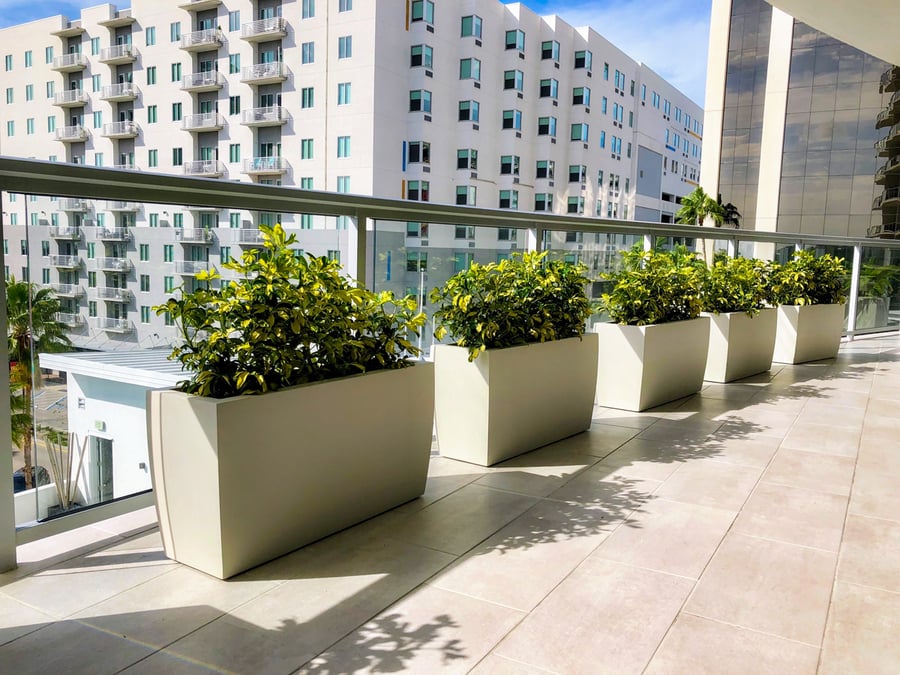There’s no better activity than upgrading and decorating your home, especially when you’re using plants. This gives your home and living space a touch of green while at the same time keeping your home decor ambitions at a low cost.
When planning ahead, we must always try and get the best plant pot to accentuate the space we’re planning on leaving it in. Not only to better improve our living space, but to ensure the plant thrives and lives its best life.
Once you know what style, color and shape you want, you’re also going to have to think about drainage and drainage holes because this plays an important role in the longevity of your plant’s life.
Improper drainage holes can cause serious damage to houseplants and can even lead to their death.
Not to worry though, today we’re going to explain how to plant in pots without drainage holes and how you’ll be able to maintain your plants and keep them healthy!
- Do plant containers need drainage holes?
- Pros of pots with drainage holes
- Pros of pots without drainage holes
- How do you plant in a pot without drainage holes?
- How do you drill drainage holes in planters?
- What potted plants don’t need drainage holes?
- In Conclusion, do indoor pots really need drainage holes?
Do plant containers need drainage holes?
As a rule of thumb, it’s recommended that your plant pot has drainage holes, most horticulturalists would even insist that it’s crucial and critical.
Having at least one drainage hole at the bottom of your planter enables healthy growth by letting excess water drain out and airflow through the soil. This helps prevent root rot from occurring, amongst other things.
However, decorative and well-designed standard and custom planters don’t necessarily have drainage holes.
The main reason?
To create a tidy and professional display of plants without creating a watery mess on the floor.
So what’s the solution?
This article is here to help you find the right balance between having healthy indoor plants, and an interior design you can be proud of.

Pros of pots with drainage holes
There are essentially four important reasons why drainage holes are good for your plant.
1. Helps remove excess water
Drainage holes help all that excess water to flow through the soil. While some plants require moist or damp soil, lots of excess water can cause root rot and can eventually lead to your plant’s death.
2. Ensures good airflow
Your plant and soil also require good airflow. Even though your soil surface is exposed at the top, you might still need the drainage hole at the bottom so air can flow through the soil.
3. Good water flow removes salt buildup
The drainage hole at the bottom of your pot will also assist your plant to drain out all excessive salts, which, if allowed to build up, could cause damage to plant roots and dry out your soil.
4. Discourages under-watering
Aside from over-watering, an opposite problem might occur. If you’re aware that your pot doesn’t have any drainage holes, you could under-water your plant in an attempt not to drown it, which is just as bad as overwatering!
Pros of pots without drainage holes
The main reason is aesthetics.
Though this seems a silly reason to sacrifice plant health and tempt death, there are clear business reasons why people don’t want to risk dirty water flowing freely from their plant displays.
With the overwhelming need for a leaky hole, there must be some solutions?
How do you plant in a pot without drainage holes?
There are a few steps you could take to grow your plants in pots without drainage holes. Bear in mind, if you do, then you need to keep a watchful eye over your plant’s growth to make sure it thrives.
Let’s take a look at a few steps you could take to grow happy, healthy plants and still keep your home or commercial space looking stylish.

Measure your plant’s water intake
This is a simple solution for allowing proper drainage in pots without drainage holes. By controlling the watering frequency, watering allowance, and increasing the size of the planters water carrying capacity, you can optimize the environment for your drain hole-less plant.
Water less often – Only water your plant when the top 2 inches of soil is dry to the touch.
Water with less water – Do some research on your plants to learn more about their ideal care regime including how much water they can take in one go.
Increase the planter size – By increasing the soil carrying capacity of your planter, you will spread any excess water further and your potting soil will dry out faster.
Add rocks to elevate your planter
Also known as drainage rocks, these small stones are around 0.5 – 1.5-inches in size. Water can easily seep out of the soil and through the rocks to allow a dry environment for your plants.
Though, pots without drainage holes may start to get full of water. A saturated plant pot will eventually drown your plant roots, so don’t be too excessive with your plant care.

A pot within a pot – a cachepot
One workaround is using two pots. If your plant does require a drainage hole and it’s unavoidable, then you can put your plant in a container with a drainage hole and then place that inside the more beautiful planter that doesn’t have one.
The pot within a pot trick is not a fool-proof drainage solution though. You’ll still need to drain out any standing water that collects at the bottom of your cache pot if it means the plant roots are in sitting water.
Using the simple method of elevating your grow pot above the floor of the cachepot means the plant’s root system won’t be waterlogged. Here’s how to do that:
Use drainage rocks
For this method, it’s recommended that you still use two pots. Within the decorative pot you can add rocks or pebbles at the bottom of the container then place the second container with the drainage holes on top of it.
Using this method, you’re creating a drainage layer that will prevent sitting water from pooling in your show planter which would otherwise create too much moisture in the soil and be problematic for your plants.
Acting as drainage materials, rocks will allow water to seep through and raise your plant away from any danger, thus allowing proper drainage for your plants.

Here is a fantastic tutorial to look after plants without drainage in small pots which can be scaled up to work with larger planters too.
How do you drill drainage holes in planters?
Though Vietnam CDM always gives you the option to have drainage holes, many other plant pot companies don’t. If you have a pot without drainage holes, and you want one, it’s quite easy to do it yourself.
Here are a couple of things you’re going to need:
- Plant pot – this can be stone or terracotta – although we highly recommend fiberglass.
- A drill
- Chamfer bit – designed to drill through fiberglass, they are less likely to cause chips.
Once you have your tools, make sure you have eye goggles because they can become quite dusty.
Flip your planter upside and use a marker to mark the center of the planter where you’re going to drill your new drainage hole.
Once everything is marked, you’re now ready to drill your hole. Remember to blow away all the excess dust caused by the planter so you can keep a clear eye on your work.
And that’s it. You now have a new pot that works with your home and it has a drainage hole that works with your plant.
What potted plants don’t need drainage holes?
If the maintenance seems like an arduous task that you’re not entirely ready to commit to, then do not worry. You’re in luck, there are some plants that don’t require drainage holes, and your options are not limited either.
Let’s take a look at the top 2 plants that don’t need a drainage hole. What’s better, these plants are usually much easier to maintain. So you’ll end up with a beautiful garden, even if you lack a green thumb:
Snake Plant
This beautiful tropical plant is of West African origin and is one of the best indoor house plants that don’t need drainage holes.
The Snake plant doesn’t need much watering or attention, which makes it perfect for beginners at gardening.
Snake plants as a whole require less maintenance and less water. So if you’re a little forgetful with your watering schedule, then this plant is ideal, and it doesn’t need a drainage hole.

Spider Plant
The Spider Plant is ideal for pots without drainage holes and also for beginner gardeners because it only requires watering when the soil is dry. So being forgetful is alright in this case.
One thing to consider with the Spider Plant is they can grow quite large and their roots can push against your planter causing it damage.
This is not the case with fiberglass planters, which are strong and durable.

For more plant options, check out our guide to the best plants that don’t need drainage holes.
In Conclusion, do indoor pots really need drainage holes?
Whether indoor or outdoor plants, most plants will need drainage holes in order to prevent the water from pooling at the bottom of the pot which can cause fungus, bacteria, and your plant’s roots to rot.
All of this must be avoided, of course. Sometimes it will take a little more effort in planning your planters (you sometimes may need to use two) or focus on using rocks or proper soil that has good drainage.
Alternatively, as mentioned above, you could opt for plants that are perfectly fine without any drainage holes, however, you will need to go easy on the watering and check if the plant’s soil is dry.

When decorating or purchasing new containers, we must always keep in mind the needs of our plants.
Lucky for you, all our planters come with optional drainage holes. just specify your preference at the time of wondering. If you opt for planters without drainage holes, at least with this article you have learned a few tricks and tips to make it work!
Don’t let drainage holes hold you back and hesitate from starting your garden or upgrading your business. Check out our fiberglass planter collection or give us a call to find the best planter solutions for you.
